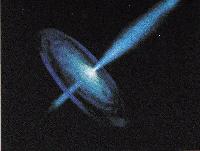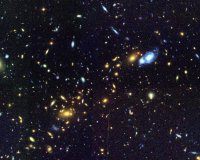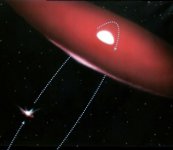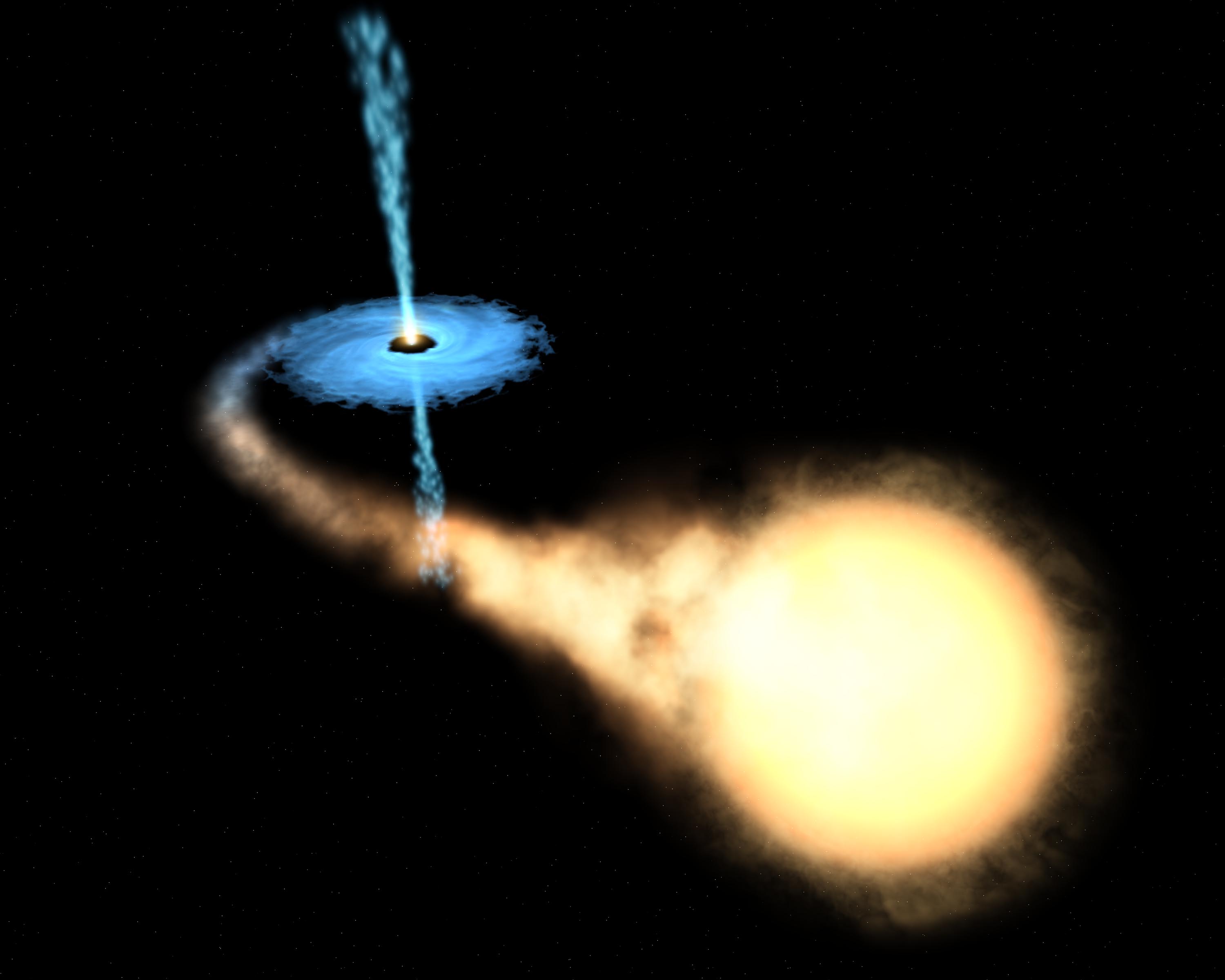Blazars And Radiogalaxies
 Blazars are thought to be radiogalaxies,
i.e. radio-loud Active Galactic Nuclei (AGN),
whose relativistic jet is pointing close to the line of sight.
Their spectral energy distribution (SED) is dominated by
two highly variable, non-thermal radiation components
peaking at low (IR-to-X-ray) and high (MeV-to-TeV) energies.
While the low-energy peak is commonly explained as synchrotron
emission from relativistic electrons, how these are accelerated
and the origin of the high-energy peak remain a major research issue,
as well as the launch, collimation and acceleration of the relativistic jet.
To this respect, the study of the correlated spectral and flux variability in
different energy bands represents a fundamental diagnostic tool.
The activity of our group has mainly concentrated on
BL Lacs, a sub-class of blazars which represent now a well established
population of TeV gamma-ray emitters and have shown the most
rapid variability and widest spectral changes (e.g. Mkn 501 and PKS 2155-304),
and on nearby radiogalaxies, as possible gamma-ray sources
(as confirmed by HEGRA and HESS with M87, and by EGRET with Centaurus A).
Our main research topics are (1) multiwavelength properties, with emphasis on
X-ray and TeV bands, comparison and modelling of the different SEDs,
tests of the "blazar sequence" scenarios; (2) jet emission mechanisms, both at
sub-pc and kpc scales, leptonic and hadronic scenarios for particle acceleration
and radiation, TeV gamma-ray production mechanisms in radiogalaxies.
Our group has proposed and organized several observations and multiwavelength
campaigns with TeV (HEGRA, HESS) and X-ray (RXTE, XMM, CHANDRA, Swift, Suzaku)
telescopes, and has a leading role in the proposal, planning and interpretation
of the AGN program in the HEGRA and HESS Collaborations.
Blazars are thought to be radiogalaxies,
i.e. radio-loud Active Galactic Nuclei (AGN),
whose relativistic jet is pointing close to the line of sight.
Their spectral energy distribution (SED) is dominated by
two highly variable, non-thermal radiation components
peaking at low (IR-to-X-ray) and high (MeV-to-TeV) energies.
While the low-energy peak is commonly explained as synchrotron
emission from relativistic electrons, how these are accelerated
and the origin of the high-energy peak remain a major research issue,
as well as the launch, collimation and acceleration of the relativistic jet.
To this respect, the study of the correlated spectral and flux variability in
different energy bands represents a fundamental diagnostic tool.
The activity of our group has mainly concentrated on
BL Lacs, a sub-class of blazars which represent now a well established
population of TeV gamma-ray emitters and have shown the most
rapid variability and widest spectral changes (e.g. Mkn 501 and PKS 2155-304),
and on nearby radiogalaxies, as possible gamma-ray sources
(as confirmed by HEGRA and HESS with M87, and by EGRET with Centaurus A).
Our main research topics are (1) multiwavelength properties, with emphasis on
X-ray and TeV bands, comparison and modelling of the different SEDs,
tests of the "blazar sequence" scenarios; (2) jet emission mechanisms, both at
sub-pc and kpc scales, leptonic and hadronic scenarios for particle acceleration
and radiation, TeV gamma-ray production mechanisms in radiogalaxies.
Our group has proposed and organized several observations and multiwavelength
campaigns with TeV (HEGRA, HESS) and X-ray (RXTE, XMM, CHANDRA, Swift, Suzaku)
telescopes, and has a leading role in the proposal, planning and interpretation
of the AGN program in the HEGRA and HESS Collaborations.
Clusters Of Galaxies
 Diffuse synchrotron radio halos are observed in a growing number of rich clusters of galaxies. This tells us that a population of relativistic electrons and a microGauss magnetic field are present in the intracluster medium. Even if the existence of relativistic electrons is firmly proved by observations, the origin of these particles and the mechanisms through which they are accelerated are still unknown. Moreover, since the majority of the acceleration mechanisms at work in astrophysical sources accelerate protons as well, it is generally assumed that a hadronic cosmic ray component will also be present in the intracluster medium. From X-ray observations we also know that clusters contain a considerable amount of baryons in the form of a hot diffuse gas. These facts led to the idea that clusters might be gamma ray sources, due to the decay of neutral pions produced in the inelastic interactions between the cosmic ray protons and the intracluster medium. This possibility was extensively studied after the discovery that relativistic protons remain diffusively confined within the cluster volume for cosmological times, without losing their energy. As a consequence, both the probability of having inelastic proton proton collisions and the related gamma ray emissivity are expected to be enhanced. Other contributions to the total gamma ray emission come from inverse Compton and Bremsstrahlung emission from relativistic electrons. All these facts make clusters of galaxies ideal targets for gamma ray telescopes operating both in the GeV and TeV energy domain.
Diffuse synchrotron radio halos are observed in a growing number of rich clusters of galaxies. This tells us that a population of relativistic electrons and a microGauss magnetic field are present in the intracluster medium. Even if the existence of relativistic electrons is firmly proved by observations, the origin of these particles and the mechanisms through which they are accelerated are still unknown. Moreover, since the majority of the acceleration mechanisms at work in astrophysical sources accelerate protons as well, it is generally assumed that a hadronic cosmic ray component will also be present in the intracluster medium. From X-ray observations we also know that clusters contain a considerable amount of baryons in the form of a hot diffuse gas. These facts led to the idea that clusters might be gamma ray sources, due to the decay of neutral pions produced in the inelastic interactions between the cosmic ray protons and the intracluster medium. This possibility was extensively studied after the discovery that relativistic protons remain diffusively confined within the cluster volume for cosmological times, without losing their energy. As a consequence, both the probability of having inelastic proton proton collisions and the related gamma ray emissivity are expected to be enhanced. Other contributions to the total gamma ray emission come from inverse Compton and Bremsstrahlung emission from relativistic electrons. All these facts make clusters of galaxies ideal targets for gamma ray telescopes operating both in the GeV and TeV energy domain.
Convertor Mechanism And Off-axis Emission
There are several viable mechanisms of particle acceleration related to relativistic outflows, e.g. through the relativistic shocks or reconnection of the magnetic field. In radiation-dominated environments they proceed in rather unusual ways. This concerns, in particular, the acceleration of electrons within high density radiation fields. Generally, fast inverse Compton losses should prevent efficient acceleration of electrons, but proceeding in Klein-Nishina regime, they can create a rather special environment, where the standard diffusive shock acceleration can be outperformed by convertor mechanism. This leads not only to more efficient acceleration, but creates a strongly anisotropic distribution of accelerated particles. This would consequently have a strong impact on the predicted spectra and fluxes of astrophysical sources, especially at high (GeV-TeV energies), which appears to be much harder compared to the predictions derived from the standard Doppler boosting considerations alone (so called off-axis emission).
Diffusive Shock Acceleration
Extragalactic Background Light
Gamma Ray Binaries
 Compact binary systems formed by a normal star and a compact object,
either a pulsar, a normal neutron star or a black-hole, have been
detected
at TeV energies. Although it is still unclear what are the details of
the
physics behind such very energetic radiation, it is unavoidable that
very
efficient particle acceleration, strong radiation fields, particle
transport and magnetic fields play an important role in the high energy
processes that produce the very high energy photons.
Compact binary systems formed by a normal star and a compact object,
either a pulsar, a normal neutron star or a black-hole, have been
detected
at TeV energies. Although it is still unclear what are the details of
the
physics behind such very energetic radiation, it is unavoidable that
very
efficient particle acceleration, strong radiation fields, particle
transport and magnetic fields play an important role in the high energy
processes that produce the very high energy photons.
 In such a context, it
is of great importance to explore the possible physical conditions that
could take place in compact binaries. Namely, it seems necessary to
simplify in a suitable manner the complex scenario that may realize in
these objects, mainly linked to relativistic outflows, such that a
meaningful comparison can be carried out between theoretical
predictions
and observational data. An accurate and solid modeling of these
sources,
in combination with good quality TeV data plus information at lower
energies, can allow to infer information about the particle nature, the
radiation, matter and magnetic fields, or the acceleration and
radiation
mechanisms, thereby constraining important properties of the emitter.
In such a context, it
is of great importance to explore the possible physical conditions that
could take place in compact binaries. Namely, it seems necessary to
simplify in a suitable manner the complex scenario that may realize in
these objects, mainly linked to relativistic outflows, such that a
meaningful comparison can be carried out between theoretical
predictions
and observational data. An accurate and solid modeling of these
sources,
in combination with good quality TeV data plus information at lower
energies, can allow to infer information about the particle nature, the
radiation, matter and magnetic fields, or the acceleration and
radiation
mechanisms, thereby constraining important properties of the emitter.
Hydrodynamics
Interstellar Medium
Molecular Clouds
 The observed diffuse gamma ray emission from the galactic plane is believed to be dominated by the decay of neutral pions produced during inelastic collisions of cosmic rays with interstellar gas. If, as a first order approximation, one assumes that the cosmic ray spectrum is the same everywhere in the Galaxy, then the gamma ray emission is expected to be simply proportional to the gas column density. As a consequence, when the line of sight of an observer intersects regions of enhanced density, such as giant molecular clouds, the gamma ray emission is expected to be correspondingly enhanced. The importance of the detection of molecular clouds in gamma rays is widely recognized, especially in relation to the problem of the origin of cosmic rays. Molecular clouds located in the vicinity of cosmic ray accelerators could provide a dense target for cosmic ray interactions, leading to an amplification of the the gamma ray emission from the region, making easier the identification of cosmic ray sources. On the other hand, even in the absence of an accelerator, molecular clouds embedded in the ``sea'' of galactic cosmic rays are expected to emit gamma rays. If cosmic rays can freely penetrate the clouds, the high energy gamma ray spectrum is expected to mimic the slope of the cosmic ray spectrum, with the total gamma ray luminosity depending only on the total mass of the cloud. For this reason, molecular clouds can be used to probe the cosmic ray energy spectrum and its absolute flux in different parts of the Galaxy. If the diffusion coefficient inside the cloud is significantly small compared to that derived for the galactic disk, the observed gamma ray spectrum will appear harder than the cosmic ray spectrum, mainly due to the slower penetration of the low energy particles towards the core of the cloud. This may produce a great variety of gamma ray spectra.
The observed diffuse gamma ray emission from the galactic plane is believed to be dominated by the decay of neutral pions produced during inelastic collisions of cosmic rays with interstellar gas. If, as a first order approximation, one assumes that the cosmic ray spectrum is the same everywhere in the Galaxy, then the gamma ray emission is expected to be simply proportional to the gas column density. As a consequence, when the line of sight of an observer intersects regions of enhanced density, such as giant molecular clouds, the gamma ray emission is expected to be correspondingly enhanced. The importance of the detection of molecular clouds in gamma rays is widely recognized, especially in relation to the problem of the origin of cosmic rays. Molecular clouds located in the vicinity of cosmic ray accelerators could provide a dense target for cosmic ray interactions, leading to an amplification of the the gamma ray emission from the region, making easier the identification of cosmic ray sources. On the other hand, even in the absence of an accelerator, molecular clouds embedded in the ``sea'' of galactic cosmic rays are expected to emit gamma rays. If cosmic rays can freely penetrate the clouds, the high energy gamma ray spectrum is expected to mimic the slope of the cosmic ray spectrum, with the total gamma ray luminosity depending only on the total mass of the cloud. For this reason, molecular clouds can be used to probe the cosmic ray energy spectrum and its absolute flux in different parts of the Galaxy. If the diffusion coefficient inside the cloud is significantly small compared to that derived for the galactic disk, the observed gamma ray spectrum will appear harder than the cosmic ray spectrum, mainly due to the slower penetration of the low energy particles towards the core of the cloud. This may produce a great variety of gamma ray spectra.
Prompt Afterglows Of Gamma Ray Bursts With ROTSE
Pulsar Wind Nebulae / Plerions
 Although, the radiation of pulsar wind nebulae are readily explained by
the standard model, which assumes acceleration of ultrarelativist
electrons by the pulsar wind termination shock, in some of these
systems
nonthermal radiation could be produced by high energy hadrons. This
radiation is expected to be produced via inelastic interactons with
the
ambient medium. In this regard the extended TeV source associated with
the
pulsar PSR B0833-45 (Vela~X) could be a good candidate for such a
"hadronic plerion". To explore this possible scenario, we work on
calculation of the high energy emission due to nucleonic processes,
including the synchrotron and IC emission from primary and secondary
electrons. The TeV neutrino production is an important feature of this
model, and our calculations show that Vela X could be one of the best
known candidates for detection of neutrinos with the next generation
km3 scale telescopes.
Another very special case of plerions is pulsars located in radiation
dominated enviroments, such as that found in the Galactic Center or
(even
more specific situation) in binary systems. Fast Inverse Compton
cooling
in the Klein-Nishina regime may result in radically different electron
spectra than those formed via synchrotron cooling. We explored these
effects and their impact on the X-ray and gamma-ray spectra produced in
electron accelerators in the central ≤ 10 pc region in comparison
to
elsewhere in our galaxy. This region appears to be the only location in
our Galaxy in which PWNe with high magnetic fields and moderate
spin-down
luminosities can produce detectable gamma-ray emission.
Although, the radiation of pulsar wind nebulae are readily explained by
the standard model, which assumes acceleration of ultrarelativist
electrons by the pulsar wind termination shock, in some of these
systems
nonthermal radiation could be produced by high energy hadrons. This
radiation is expected to be produced via inelastic interactons with
the
ambient medium. In this regard the extended TeV source associated with
the
pulsar PSR B0833-45 (Vela~X) could be a good candidate for such a
"hadronic plerion". To explore this possible scenario, we work on
calculation of the high energy emission due to nucleonic processes,
including the synchrotron and IC emission from primary and secondary
electrons. The TeV neutrino production is an important feature of this
model, and our calculations show that Vela X could be one of the best
known candidates for detection of neutrinos with the next generation
km3 scale telescopes.
Another very special case of plerions is pulsars located in radiation
dominated enviroments, such as that found in the Galactic Center or
(even
more specific situation) in binary systems. Fast Inverse Compton
cooling
in the Klein-Nishina regime may result in radically different electron
spectra than those formed via synchrotron cooling. We explored these
effects and their impact on the X-ray and gamma-ray spectra produced in
electron accelerators in the central ≤ 10 pc region in comparison
to
elsewhere in our galaxy. This region appears to be the only location in
our Galaxy in which PWNe with high magnetic fields and moderate
spin-down
luminosities can produce detectable gamma-ray emission.
Supernova Remnants
 In 1934, Baade and Zwicky first proposed that supernovae are the sources of galactic cosmic rays (CR). To support their idea, they used a simple argument: the observed CR population can be maintained at the present level if a small fraction (a few percent) of the galactic supernovae kinetic energy is somehow converted into CR. This argument is strengthened by the fact that it is commonly believed that CR can be efficiently accelerated via the Fermi mechanism at shock waves that form during the expansion of supernova remnant in the interstellar medium. The acceleration of CR in supernova remnants must be accompanied by a copious gamma ray emission due to the decay of neutral pions produced in interactions between relativistic protons and protons in the interstellar medium. Because the energy transferred to accelerated particles is tightly constrained by the observed total CR power, it is possible to obtain an almost model independent prediction of the gamma ray luminosity of supernova remnants. Recently, the HESS telescope detected a few supernova remnants at TeV energies, whose flux level matches very well the above mentioned predictions. Though the HESS results undoubtedly constitute one of the most important advancements in the field, they still do not provide us with a definite and direct evidence of proton acceleration at supernova remnants. In fact, competing leptonic processes can also generate gamma rays, and thus an accurate modelling is needed in order to disentangle the different contributions. Also neutrinos are produced during the hadronic interactions responsible for the generation of gamma rays. Their detection, though challenging even for the next generation of telescopes, would constitute an unambiguous proof for proton acceleration in these objects.
In 1934, Baade and Zwicky first proposed that supernovae are the sources of galactic cosmic rays (CR). To support their idea, they used a simple argument: the observed CR population can be maintained at the present level if a small fraction (a few percent) of the galactic supernovae kinetic energy is somehow converted into CR. This argument is strengthened by the fact that it is commonly believed that CR can be efficiently accelerated via the Fermi mechanism at shock waves that form during the expansion of supernova remnant in the interstellar medium. The acceleration of CR in supernova remnants must be accompanied by a copious gamma ray emission due to the decay of neutral pions produced in interactions between relativistic protons and protons in the interstellar medium. Because the energy transferred to accelerated particles is tightly constrained by the observed total CR power, it is possible to obtain an almost model independent prediction of the gamma ray luminosity of supernova remnants. Recently, the HESS telescope detected a few supernova remnants at TeV energies, whose flux level matches very well the above mentioned predictions. Though the HESS results undoubtedly constitute one of the most important advancements in the field, they still do not provide us with a definite and direct evidence of proton acceleration at supernova remnants. In fact, competing leptonic processes can also generate gamma rays, and thus an accurate modelling is needed in order to disentangle the different contributions. Also neutrinos are produced during the hadronic interactions responsible for the generation of gamma rays. Their detection, though challenging even for the next generation of telescopes, would constitute an unambiguous proof for proton acceleration in these objects.
 In the mid 1990s, the concept of stereoscopic arrays of 10m diameter class
imaging Cherenkov telescopes observing Cherenkov light of air showers simultaneously
at different angles, was recognized as the most promising approach to
dramatically improve the sensitivity and push the detection threshold down to 100 GeV [see
In the mid 1990s, the concept of stereoscopic arrays of 10m diameter class
imaging Cherenkov telescopes observing Cherenkov light of air showers simultaneously
at different angles, was recognized as the most promising approach to
dramatically improve the sensitivity and push the detection threshold down to 100 GeV [see